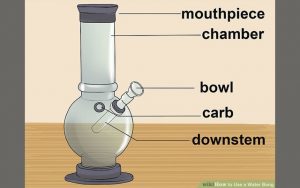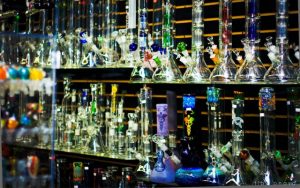Call them what you will: bongs, straight shooters, bubblers, hookahs, calabash, corn-cob, hubble-bubble, whatever. A bong is a brilliant bit of kit and has been in use, in one form or another, for hundreds (possibly thousands) of years. The name comes from baung, the Thai word for “cylindrical wooden tube”. That is a fair description, though these days there are many types of bongs and waterpipes available in various materials such as plastic, glass, ceramic, bamboo and even paper bongs are available to buy or to make.
What is a Bong?
 Typically used for consuming the cannabis herb, a bong is a long tube, sealed at one end, with usually two or three openings. One opening is at the end of the tube for the mouth, one is for the bowl where the herbs are burned, and the other is a “speed-hole”, or the hole covered and uncovered to allow the chamber to fill with smoke and then be emptied.
Typically used for consuming the cannabis herb, a bong is a long tube, sealed at one end, with usually two or three openings. One opening is at the end of the tube for the mouth, one is for the bowl where the herbs are burned, and the other is a “speed-hole”, or the hole covered and uncovered to allow the chamber to fill with smoke and then be emptied.
The herb is placed into the bowl, usually on top of a gauze or plug of tobacco and set alight. The user then places their mouth over the end and inhales, burning the herb as s/he does so. This pulls the smoke into the chamber of the bong, where it can be bubbled through water, ice or whatever else you can think of to cool down the smoke. Once the herb supply is exhausted or the chamber is full, the bowl is lifted away, or the speed-hole uncovered, allowing the user to inhale the smoke contained therein.
This is usually accompanied by a fit of coughing as bongs can be harsh things to inhale from.
Why Bong?
To bong or not to bong? The alternatives are smoking the herb in a cigarette, eating the extract in edibles or vaporizing them in a vaporizer. A bong is a cheap and effective way of getting a very pure hit of smoke, very quickly. They require little maintenance besides changing the water and gauzes, and occasionally giving them a wash. No charging required, just ground herbs, cold water and a good lung capacity.
Bongs can be used without tobacco, making them an excellent alternative to those who like to smoke their herbs but do not like the hideous consequences of smoking tobacco. They also give a full and flavoursome experience that is quite unlike a vaporizer or cigarette. The active ingredients in your herbs get into your bloodstream extremely quickly, giving an almost instant effect. This can be very desirable.
The rise of cheap and efficient vaporizers has side-lined bongs to some extent. Vaporizers are relatively safe when compared with bonging and can give a similar effect. However, the experience of a bong is hard to beat for many people and is the reason for their enduring popularity.
Types of Bongs
These names are general, as there are as many names for any of these bongs as would fill this entire review, so just go with it. The types often overlap and are not hard and fast – there are no rules when it comes to bongs.
The Straight Shooter – As simple as they come, the straight shooter is just a tube with the right number of holes and somewhere to burn the herbs. Used with or without water (depending on the bowl), a straight shooter is a no-nonsense way of getting your herbal extract into your bloodstream as quickly as possible.
The Bubbler – Designed specifically for bubbling the smoke through a liquid (usually water but red wine or orange juice are popular alternatives), a bubbler is a more pleasant smoking experience than one without a fluid in the chamber. A water bong not only cools the smoke but filters it too, making sure that the smoke that you get in the hit is not full of little hot particles that will make you choke. A vastly superior method of imbibing your herbs.
The Party Piece – Usually of ridiculous proportions, this kind of bong is made for sharing. Most of them are built for use with water and even with little indents to keep ice in place, a party piece can fill with huge amounts of smoke for ripping competitions, puff-puff-pass, or general sociability. A difficult thing to master, the filling of a lengthy bong like this, but when the huge bowl has been burnt and the tube is filled with thick smoke, not much compares to the feeling of anticipation it gives.
The Pocket Bong – Small and designed for a more discreet way of consuming your dried herbs, a pocket bong makes for quick and simple bonging with relatively good results. The small chamber limits the size of the hit and the amount of cooling the smoke gets, so they cannot compare to a larger beast for quality of smoke or smoothness. But they are very useful nonetheless.
Hookahs – These are not bongs, strictly speaking, but often get conflated as the same. Coals heat the herbs on top of the bubble chamber, and when the user pulls on the breathing tube, the coals heat up, burn the herbs, the smoke is pulled through the water and the user gets nice, thick and tasty smoke. Usually used with tobacco, they can be used with any dried or flavoured herbs.
Glass Bongs – Glass has excellent heat insulating qualities, making it perfect for delivering cool hits on the bong. The best bongs for sale are made from glass, and while many herb smokers have inadvertently knocked one off the table and smashed one, much to their dismay, the clear advantages of a glass bong mean it is not long until they go buy another. For purists, the glass does not react with hot smoke and ensures only the chemicals you want are coming at you, not weird melted plastic things.
The Percolator Bong – These are the pinnacle of bong technology. Containing more than one chamber so the smoke has extra time to chill before it encounters your sensitive lungs, percolator bongs can be wildly complicated and extremely expensive. There are loads of options available, with removable bowls, ice chambers, filters, spiral tubing for maximum surface area, dual draws for easy use, the list goes on. For a serious herb smoker, a percolator bong requires a little extra lung effort to draw but gives easily the best results.
Percolators have the best cooling capacity of any bong type, and the quality of the smoke you get from them is testament to this extended cooling pathway. They are delicate and are sometimes very difficult to clean, but they are worth it for the experience. Often made from hand-blown glass, percolator bongs vary endlessly in price and capabilities. Not for the beginner herb bonger; they are for the dedicated.
Prices
 You can pick up a bong for less than £10 and it will be OK. Glass blown ones are little more expensive but are worth the extra cost. Then it depends on what features you want and how well made you want it to be. Enjoy!
You can pick up a bong for less than £10 and it will be OK. Glass blown ones are little more expensive but are worth the extra cost. Then it depends on what features you want and how well made you want it to be. Enjoy!






